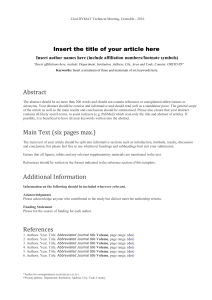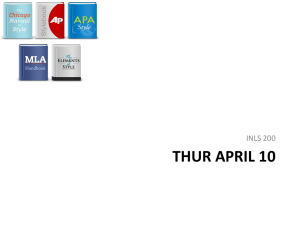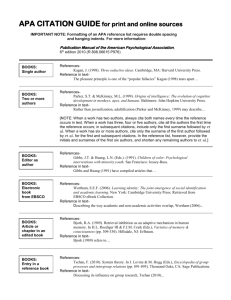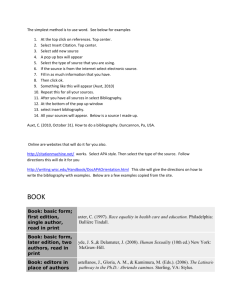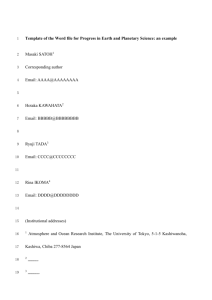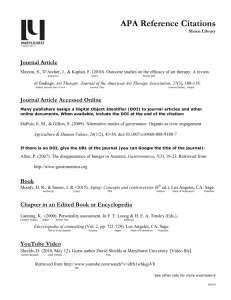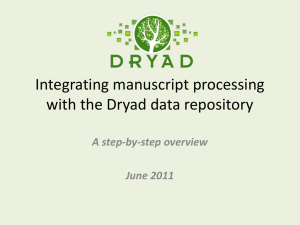manuscript template
advertisement
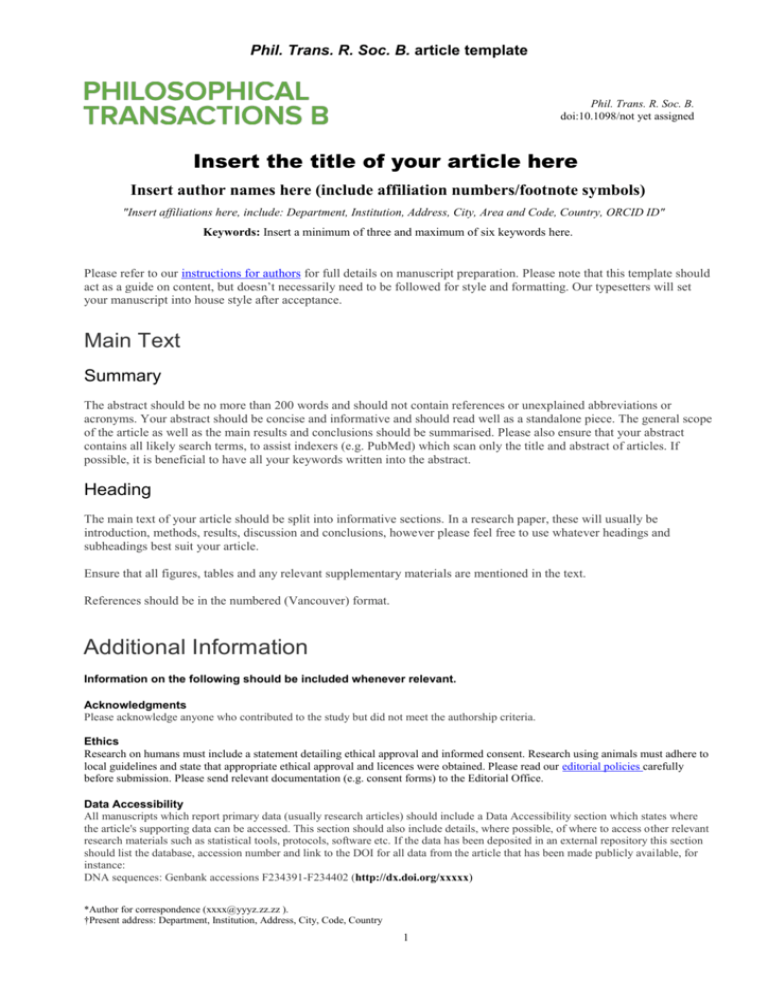
Phil. Trans. R. Soc. B. article template Phil. Trans. R. Soc. B. doi:10.1098/not yet assigned Insert the title of your article here Insert author names here (include affiliation numbers/footnote symbols) "Insert affiliations here, include: Department, Institution, Address, City, Area and Code, Country, ORCID ID" Keywords: Insert a minimum of three and maximum of six keywords here. Please refer to our instructions for authors for full details on manuscript preparation. Please note that this template should act as a guide on content, but doesn’t necessarily need to be followed for style and formatting. Our typesetters will set your manuscript into house style after acceptance. Main Text Summary The abstract should be no more than 200 words and should not contain references or unexplained abbreviations or acronyms. Your abstract should be concise and informative and should read well as a standalone piece. The general scope of the article as well as the main results and conclusions should be summarised. Please also ensure that your abstract contains all likely search terms, to assist indexers (e.g. PubMed) which scan only the title and abstract of articles. If possible, it is beneficial to have all your keywords written into the abstract. Heading The main text of your article should be split into informative sections. In a research paper, these will usually be introduction, methods, results, discussion and conclusions, however please feel free to use whatever headings and subheadings best suit your article. Ensure that all figures, tables and any relevant supplementary materials are mentioned in the text. References should be in the numbered (Vancouver) format. Additional Information Information on the following should be included whenever relevant. Acknowledgments Please acknowledge anyone who contributed to the study but did not meet the authorship criteria. Ethics Research on humans must include a statement detailing ethical approval and informed consent. Research using animals must adhere to local guidelines and state that appropriate ethical approval and licences were obtained. Please read our editorial policies carefully before submission. Please send relevant documentation (e.g. consent forms) to the Editorial Office. Data Accessibility All manuscripts which report primary data (usually research articles) should include a Data Accessibility section which states where the article's supporting data can be accessed. This section should also include details, where possible, of where to access other relevant research materials such as statistical tools, protocols, software etc. If the data has been deposited in an external repository this section should list the database, accession number and link to the DOI for all data from the article that has been made publicly available, for instance: DNA sequences: Genbank accessions F234391-F234402 (http://dx.doi.org/xxxxx) *Author for correspondence (xxxx@yyyz.zz.zz ). †Present address: Department, Institution, Address, City, Code, Country 1 Phylogenetic data, including alignments: TreeBASE accession number S9123 (http://dx.doi.org/xxxxx) Climate data and MaxEnt input files: Dryad doi:10.5521/dryad.12311 (http://dx.doi.org/xxxxx) If the data is included in the article’s Supplementary Material this should be stated here, for instance: The datasets supporting this article have been uploaded as part of the Supplementary Material. Authors' Contributions All submissions, other than those with a single author, must include an Authors’ Contributions section which individually lists the specific contribution of each author. The list of Authors should meet all of the following criteria; 1) substantial contributions to conception and design, or acquisition of data, or analysis and interpretation of data; 2) drafting the article or revising it critically for important intellectual content; and 3) final approval of the version to be published. All contributors who do not meet all of these criteria should be included in the acknowledgements. Competing Interests All manuscripts must include a competing interests section. If you have no competing interests please state ‘I/We have no competing interests.’ Competing interests are defined as those that, through their potential influence on behaviour or content or from perception of such potential influences, could undermine the objectivity, integrity or perceived value of publication. For more details please read our editorial policies. You must disclose any relationships, whether professional or personal, with the Guest Editors of the issue. Funding Please list the source of funding for each author. References 1. Authors. Year. Title. Abbreviated Journal title Volume, page range. (doi) 2. Authors. Year. Title. Abbreviated Journal title Volume, page range. (doi) 3. Authors. Year. Title. Abbreviated Journal title Volume, page range. (doi) 4. Authors. Year. Title. Abbreviated Journal title Volume, page range. (doi) 5. Authors. Year. Title. Abbreviated Journal title Volume, page range. (doi) 6. Authors. Year. Title. Abbreviated Journal title Volume, page range. (doi) Tables Tables should be inserted at the end of the document, unless they are provided in another format (e.g. Excel) in which case they should be supplied as a separate file. Please provide all tables in an editable format (rather than embedded as an image). Figure and table captions Table and figure captions should be included at the end of the manuscript file and should be brief and informative. Ensure that permission has been obtained for all use of third party or previously published figures, and include full credit information. If publishing an open access paper, permission must be cleared for this use. Please let the Editorial Office know of any copyright issues. Figures For final submissions, figures should be uploaded as separate, high resolution, figure files. Supplementary material Supplementary material can be used for supporting data sets, movies, figures and tables, and any other supporting material. The main article, however, should stand on its own merit. Where possible, supplementary material should be combined into one Word document or PDF. A template is available on our website, or on request.
